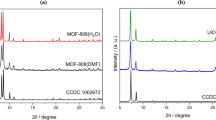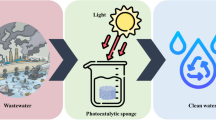Abstract
Graphene materials have been extensively verified as a good adsorbent for tackling wastewater containing various aromatic pollutants; however, little attention has been paid to understanding the graphene-based adsorption mechanism. Here, a systematic work is performed to prepare a series of graphene oxide (GO)-incorporated polyacrylamide hydrogels, with a three-dimensional (3D) monolithic structure, followed by in situ conversion of GO to reduced graphene oxide. Such a method not only enables the prevention of irreversible aggregation of graphene sheets during the in situ reduction, but also facilitates the clarification of the relationship between the structure and adsorption properties of the graphene materials. This work presents two kinds of graphene-based 3D monolithic adsorbents for either selective separation of the cationic aromatic pollutant from anionic one or uptake both of them for the total purification purpose. More importantly, we effectively unravel that the sp2-conjugated carbon network of the graphene materials plays a pivotal role in purifying the aromatic organic pollutants through π–π stacking interactions that outstrip electrostatic attraction interactions. Therefore, the present work is expected to provide an impetus toward exploration of high-performance graphene-based materials for various applications, especially environmental remediation, on the basis of effectively impeding self-aggregation of graphene sheets and judiciously modulating their intrinsic structure.











Similar content being viewed by others
References
Huang Z-H, Zheng X, Lv W, Wang M, Yang Q-H, Kang F (2011) Adsorption of lead(II) ions from aqueous solution on low-temperature exfoliated graphene nanosheets. Langmuir 27:7558. doi:10.1021/la200606r
Allen MJ, Tung VC, Kaner RB (2010) Honeycomb carbon: a review of graphene. Chem Rev 110:132. doi:10.1021/cr900070d
Dreyer DR, Park S, Bielawski CW, Ruoff RS (2010) The chemistry of graphene oxide. Chem Soc Rev 39:228. doi:10.1039/b917103g
Guo S, Dong S (2011) Graphene nanosheet: synthesis, molecular engineering, thin film, hybrids, and energy and analytical applications. Chem Soc Rev 40:2644. doi:10.1039/c0cs00079e
Hu H, Xin JH, Hu H, Wang X, Kong Y (2015) Metal-free graphene-based catalyst—Insight into the catalytic activity: a short review. Appl Catal A Gen 492:1. doi:10.1016/j.apcata.2014.11.041
Hu H, Xin JH, Hu H, Wang X, Miao D, Liu Y (2015) Synthesis and stabilization of metal nanocatalysts for reduction reactions – a review. J Mater Chem A 3:11157. doi:10.1039/c5ta00753d
Hu H, Wang X, Lee KI, Ma K, Hu H, Xin JH (2016) Graphene oxide-enhanced sol-gel transition sensitivity and drug release performance of an amphiphilic copolymer-based nanocomposite. Sci Rep 6:31815. doi:10.1038/srep31815
Ciriminna R, Zhang N, Yang M-Q, Meneguzzo F, Xu Y-J, Pagliaro M (2015) Commercialization of graphene-based technologies: a critical insight. Chem Commun 51:7090. doi:10.1039/c5cc01411e
Hu H, Xin J, Hu H, Wang X, Lu X (2014) Organic liquids-responsive β-cyclodextrin-functionalized graphene-based fluorescence probe: label-free selective detection of tetrahydrofuran. Molecules 19:7459. doi:10.3390/molecules19067459
Hu H, Allan CCK, Li J et al (2014) Multifunctional organically modified graphene with super-hydrophobicity. Nano Res 7:418. doi:10.1007/s12274-014-0408-0
Wu Z-S, Ren W, Wen L et al (2010) Graphene anchored with Co3O4 nanoparticles as anode of lithium ion batteries with enhanced reversible capacity and cyclic performance. ACS Nano 4:3187. doi:10.1021/nn100740x
Soo LT, Loh KS, Mohamad AB, Daud WRW, Wong WY (2015) An overview of the electrochemical performance of modified graphene used as an electrocatalyst and as a catalyst support in fuel cells. Appl Catal A Gen 497:198. doi:10.1016/j.apcata.2015.03.008
Qiu J, Wang S (2011) Enhancing polymer performance through graphene sheets. J Appl Polym Sci 119:3670. doi:10.1002/app.33068
Gao E, Wang W, Shang M, Xu J (2011) Synthesis and enhanced photocatalytic performance of graphene-Bi2WO6composite. Phys Chem Chem Phys 13:2887. doi:10.1039/c0cp01749c
Moon IK, Lee J, Ruoff RS, Lee H (2010) Reduced graphene oxide by chemical graphitization. Nat Commun 1:73. doi:10.1038/ncomms1067
An X, Yu JC, Wang Y, Hu Y, Yu X, Zhang G (2012) WO3 nanorods/graphene nanocomposites for high-efficiency visible-light-driven photocatalysis and NO2 gas sensing. J Mater Chem 22:8525. doi:10.1039/c2jm16709c
Lin TW, Dai CS, Hung KC (2014) High energy density asymmetric supercapacitor based on NiOOH/Ni3S2/3D graphene and Fe3O4/graphene composite electrodes. Sci Rep 4:7274. doi:10.1038/srep07274
Zhu J, Wei S, Gu H et al (2012) One-pot synthesis of magnetic graphene nanocomposites decorated with core@double-shell nanoparticles for fast chromium removal. Environ Sci Technol 46:977. doi:10.1021/es2014133
Yang S-T, Chen S, Chang Y, Cao A, Liu Y, Wang H (2011) Removal of methylene blue from aqueous solution by graphene oxide. J Colloid Interface Sci 359:24. doi:10.1016/j.jcis.2011.02.064
Han Z, Tang Z, Shen S, Zhao B, Zheng G, Yang J (2014) Strengthening of graphene aerogels with tunable density and high adsorption capacity towards Pb2+. Sci Rep. doi:10.1038/srep05025
Xue Z, Zhao S, Zhao Z, Li P, Gao J (2016) Thermodynamics of dye adsorption on electrochemically exfoliated graphene. J Mater Sci 51:4928. doi:10.1007/s10853-016-9798-6
Zhang L, Li X, Wang M et al (2016) Highly flexible and porous nanoparticle-loaded films for dye removal by graphene oxide–fungus interaction. ACS Appl Mater Interfaces 8:34638. doi:10.1021/acsami.6b10920
Wan Q, Liu M, Xie Y et al (2016) Facile and highly efficient fabrication of graphene oxide-based polymer nanocomposites through mussel-inspired chemistry and their environmental pollutant removal application. J Mater Sci 52:504. doi:10.1007/s10853-016-0349-y
Zhang J, Xiao H, Yang Y (2014) Preparation of hemicellulose-containing latex and its application as absorbent toward dyes. J Mater Sci 50:1673. doi:10.1007/s10853-014-8728-8
Duru İ, Ege D, Kamali AR (2016) Graphene oxides for removal of heavy and precious metals from wastewater. J Mater Sci 51:6097. doi:10.1007/s10853-016-9913-8
Hong J-Y, Sohn E-H, Park S, Park HS (2015) Highly-efficient and recyclable oil absorbing performance of functionalized graphene aerogel. Chem Eng J 269:229. doi:10.1016/j.cej.2015.01.066
Dong X, Chen J, Ma Y et al (2012) Superhydrophobic and superoleophilic hybrid foam of graphene and carbon nanotube for selective removal of oils or organic solvents from the surface of water. Chem Commun 48:10660. doi:10.1039/c2cc35844a
Gao Y, Li Y, Zhang L et al (2012) Adsorption and removal of tetracycline antibiotics from aqueous solution by graphene oxide. J Colloid Interface Sci 368:540. doi:10.1016/j.jcis.2011.11.015
Shen Y, Fang Q, Chen B (2015) Environmental applications of three-dimensional graphene-based macrostructures: adsorption, transformation, and detection. Environ Sci Technol 49:67. doi:10.1021/es504421y
Wang X, Hu H, Yang Z, Kong Y, Fei B, Xin JH (2015) Visible light-active sub-5 nm anatase TiO2 for photocatalytic organic pollutant degradation in water and air, and for bacterial disinfection. Catal Commun 72:81. doi:10.1016/j.catcom.2015.09.014
Wang X, Hu H, Wang W et al (2016) Antibacterial modification of an injectable, biodegradable, non-cytotoxic block copolymer-based physical gel with body temperature-stimulated sol-gel transition and controlled drug release. Colloids Surf B 143:342. doi:10.1016/j.colsurfb.2016.02.008
Barhoum A, Melcher J, Van Assche G et al (2016) Synthesis, growth mechanism, and photocatalytic activity of Zinc oxide nanostructures: porous microparticles versus nonporous nanoparticles. J Mater Sci 52:2746. doi:10.1007/s10853-016-0567-3
Kim K-J, Park J-W (2016) Stability and reusability of amine-functionalized magnetic-cored dendrimer for heavy metal adsorption. J Mater Sci 52:843. doi:10.1007/s10853-016-0380-z
Chowdhury S, Balasubramanian R (2014) Recent advances in the use of graphene-family nanoadsorbents for removal of toxic pollutants from wastewater. Adv Colloid Interface Sci 204:35. doi:10.1016/j.cis.2013.12.005
Gao H, Sun Y, Zhou J, Xu R, Duan H (2013) Mussel-inspired synthesis of polydopamine-functionalized graphene hydrogel as reusable adsorbents for water purification. ACS Appl Mater Interfaces 5:425. doi:10.1021/am302500v
Fan L, Luo C, Sun M, Li X, Lu F, Qiu H (2012) Preparation of novel magnetic chitosan/graphene oxide composite as effective adsorbents toward methylene blue. Bioresour Technol 114:703. doi:10.1016/j.biortech.2012.02.067
Gul K, Sohni S, Waqar M, Ahmad F, Norulaini NAN, MO AK (2016) Functionalization of magnetic chitosan with graphene oxide for removal of cationic and anionic dyes from aqueous solution. Carbohydr Polym 152:520. doi:10.1016/j.carbpol.2016.06.045
Cheng C, Deng J, Lei B et al (2013) Toward 3D graphene oxide gels based adsorbents for high-efficient water treatment via the promotion of biopolymers. J Hazard Mater 263:467. doi:10.1016/j.jhazmat.2013.09.065
Sun H, Cao L, Lu L (2011) Magnetite/reduced graphene oxide nanocomposites: one step solvothermal synthesis and use as a novel platform for removal of dye pollutants. Nano Res 4:550. doi:10.1007/s12274-011-0111-3
Zhang L, Wang T, Wang H, Meng Y, Yu W, Chai L (2013) Graphene@poly(m-phenylenediamine) hydrogel fabricated by a facile post-synthesis assembly strategy. Chem Commun 49:9974. doi:10.1039/c3cc45261a
Hu H, Xin JH, Hu H (2014) PAM/graphene/Ag ternary hydrogel: synthesis, characterization and catalytic application. J Mater Chem A 2:11319. doi:10.1039/c4ta01620c
Hu H-W, Xin JH, Hu H (2013) Highly efficient graphene-based ternary composite catalyst with polydopamine layer and copper nanoparticles. ChemPlusChem 78:1483. doi:10.1002/cplu.201300124
Hu H, Xin JH, Hu H, Chan A, He L (2013) Glutaraldehyde–chitosan and poly (vinyl alcohol) blends, and fluorescence of their nano-silica composite films. Carbohydr Polym 91:305. doi:10.1016/j.carbpol.2012.08.038
Huang Y, Zhang M, Ruan W (2014) High-water-content graphene oxide/polyvinyl alcohol hydrogel with excellent mechanical properties. J Mater Chem A 2:10508. doi:10.1039/c4ta01464b
Hu H, Wang X, Miao D et al (2015) A pH-mediated enhancement of the graphene carbocatalyst activity for the reduction of 4-nitrophenol. Chem Commun 51:16699. doi:10.1039/c5cc05826k
Hu H, Xin JH, Hu H, Wang X (2015) Structural and mechanistic understanding of an active and durable graphene carbocatalyst for reduction of 4-nitrophenol at room temperature. Nano Res 8:3992. doi:10.1007/s12274-015-0902-z
Fan J, Shi Z, Lian M, Li H, Yin J (2013) Mechanically strong graphene oxide/sodium alginate/polyacrylamide nanocomposite hydrogel with improved dye adsorption capacity. J Mater Chem A 1:7433. doi:10.1039/c3ta10639j
Liu R, Liang S, Tang X-Z, Yan D, Li X, Yu Z-Z (2012) Tough and highly stretchable graphene oxide/polyacrylamide nanocomposite hydrogels. J Mater Chem 22:14160. doi:10.1039/c2jm32541a
Balandin AA (2011) Thermal properties of graphene and nanostructured carbon materials. Nat Mater 10:569. doi:10.1038/nmat3064
Xiao J, Lv W, Xie Z, Tan Y, Song Y, Zheng Q (2016) Environmentally friendly reduced graphene oxide as a broad-spectrum adsorbent for anionic and cationic dyes via π–π interactions. J Mater Chem A 4:12126. doi:10.1039/c6ta04119a
Ghorai S, Sarkar A, Raoufi M, Panda AB, Schonherr H, Pal S (2014) Enhanced removal of methylene blue and methyl violet dyes from aqueous solution using a nanocomposite of hydrolyzed polyacrylamide grafted xanthan gum and incorporated nanosilica. ACS Appl Mater Interfaces 6:4766. doi:10.1021/am4055657
Li D, Müller MB, Gilje S, Kaner RB, Wallace GG (2008) Processable aqueous dispersions of graphene nanosheets. Nat Nanotechnol 3:101. doi:10.1038/nnano.2007.451
Acknowledgements
The authors greatly appreciate the special funding project of the technical innovation of Foshan city (2014AG10009), the self-innovation promotion project of the universities in Guangdong province (2015KQNCX178), and research center project of engineering technology of Foshan City (2014GA000355).
Author information
Authors and Affiliations
Corresponding authors
Electronic supplementary material
Below is the link to the electronic supplementary material.
Rights and permissions
About this article
Cite this article
Hu, H., Chang, M., Zhang, M. et al. A new insight into PAM/graphene-based adsorption of water-soluble aromatic pollutants. J Mater Sci 52, 8650–8664 (2017). https://doi.org/10.1007/s10853-017-1090-x
Received:
Accepted:
Published:
Issue Date:
DOI: https://doi.org/10.1007/s10853-017-1090-x




